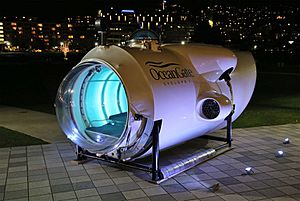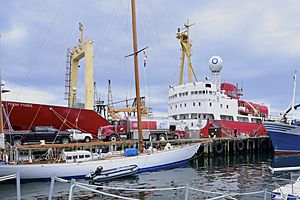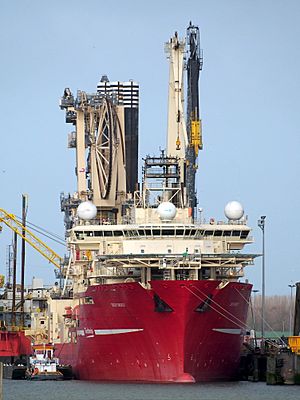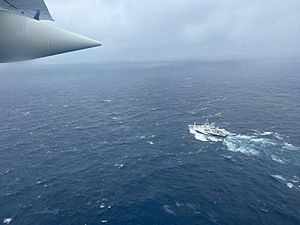Titan submersible implosion facts for kids
| Date | 18 June 2023 |
|---|---|
| Location | North Atlantic Ocean, near the wreck of the Titanic |
| Type | Maritime disaster |
| Cause | Failure of the pressure hull |
| Participants | 5 passengers |
| Outcome | Submersible destroyed by implosion |
| Deaths | 5 (see § Fatalities) |
On 18 June 2023, Titan, a submersible, went missing in international waters in the North Atlantic Ocean off the coast of Newfoundland, Canada. A submersible is like a simple submarine. The submersible with five people on board was on a tourist expedition to view the wreck of RMS Titanic. Communication was lost 1 hour and 45 minutes into its dive to the wreck site; authorities were notified when it did not resurface at its scheduled time later that day.
On 22 June, after nearly 80 hours of searching, a remotely operated underwater vehicle (ROV) discovered a debris field with parts of the Titan approximately 488 m (1,600 ft) from the bow of the Titanic. The pressure vessel probably imploded during or after the Titan's descent, killing all on board instantly.
Concerns about the safety of the vessel had previously been raised. Search and rescue efforts were carried out by an international team led by the United States Coast Guard, United States Navy, and Canadian Coast Guard. Aircraft from the Royal Canadian Air Force and United States Air National Guard, a Royal Canadian Navy ship. Several commercial and research ships and ROVs also helped with the search.
Contents
Crew and passengers
- Stockton Rush, an American submersible pilot and businessman. He was the chief executive and founding member of OceanGate.
- Shahzada Dawood, a Pakistani-British businessman (of the Dawood Hercules Corporation), and trustee at the SETI Institute. He was one of the wealthiest people in Pakistan.
- Suleman Dawood, the 19-year-old son of Shahzada Dawood, a student at the University of Strathclyde.
- Hamish Harding, a British businessman, aviator, and space tourist. He had previously descended into the Mariana Trench, broken the Guinness World Record for a circumnavigation of the Earth, and flew into space in 2022 on Blue Origin NS-21.
- Paul-Henri Nargeolet, a former French Navy commander, diver, submersible pilot, member of the French Institute for Research and Exploitation of the Sea (IFREMER), and director of underwater research for E/M Group and RMS Titanic, Inc., which owns salvage rights to the wreckage site. Nargeolet led more than 35 expeditions to the wreck, supervised the recovery of thousands of artifacts, and was "widely considered the leading authority on the wreck site" according to The Guardian.
Titan submersible
Titan was a five-person submersible vessel operated by OceanGate, Inc. The 6.7-metre-long (22 ft), 10,432 kg (23,000 lb) vessel was constructed from carbon fibre and titanium. The entire pressure vessel consisted of two titanium hemispheres, two matching titanium interface rings, and the 142 cm (56 in) internal diameter, 2.4-metre-long (7.9 ft) carbon fibre-wound cylinder. One of the titanium hemispherical end caps was fitted with a 380 mm-diameter (15 in) acrylic window.
Titan's steering controls consisted of a Logitech F710 wireless game controller with modified analogue sticks. It would move at up to 3 knots (5.6 km/h; 3.5 mph) using four electric thrusters, arrayed two horizontal and two vertical.
OceanGate claimed on its website as of 2023 that Titan was "designed and engineered by OceanGate Inc. in collaboration [with] experts from NASA, Boeing, and the University of Washington" (UW). A 1⁄3-scale model of the Cyclops 2 pressure vessel was built and tested at the Applied Physics Laboratory (APL) at UW; the model was able to sustain a pressure of 4,285 psi (29.54 MPa; 291.6 atm), corresponding to a depth of approximately 3,000 m (9,800 ft). After the disappearance of the Titan in 2023, UW claimed the APL had no involvement in "design, engineering, or testing of the Titan submersible." A Boeing spokesperson also claimed Boeing "was not a partner on the Titan and did not design or build it." A NASA spokesperson said that NASA's Marshall Space Flight Center had a Space Act Agreement with OceanGate, but "did not conduct testing and manufacturing via its workforce or facilities".
According to OceanGate, the vessel contained monitoring systems to continuously monitor the strength of the hull. The vessel had life support for five crew members for 96 hours. There was no on-board navigation system; the support ship, which monitored the position of Titan relative to its target, sent text messages to Titan providing distances and directions.
According to OceanGate, the Titan had seven backup systems intended to return the vessel to surface in case of emergency, including ballasts that could be dropped, a balloon, and thrusters. Some of the backup systems were designed to work even if all aboard the submersible were unconscious; there were sandbags held by hooks that dissolved after a certain number of hours in the water to release the sandbags, ideally letting the vessel float to the surface. An OceanGate investor explained that if the vessel did not automatically ascend after the elapsed time, those inside the vessel could help release the ballast either by tilting the ship back and forth to dislodge it or by utilizing a pneumatic pump to loosen the weights.
Expeditions to the Titanic
The Titan made its first dive to the Titanic in July 2021. It made additional dives in 2022 and 2023.
Each dive typically had a pilot, three paying passengers, and a guide on board. Once these people were inside the submersible, the hatch would be bolted shut and could only be reopened from the outside. The descent from the surface to the Titanic typically took two hours, with the full dive taking approximately eight hours. Throughout the journey, the submersible was expected to emit a safety ping every 15 minutes to be monitored by the above-water crew. The vessel and surface crew were also able to communicate via short text messages.
Customers who travelled to the Titanic with OceanGate, referred to as "mission specialists" by the company, spent US$250,000 to be involved in the eight-day expedition.
OceanGate intended to conduct multiple dives to the Titanic's wreck in 2023, but the dive in which Titan was destroyed was the only one the company had launched that year.
Incident
On 16 June 2023, the expedition to the Titanic's wreck departed from St. John's, Newfoundland, aboard the research and expedition ship MV Polar Prince.
The ship arrived at the dive site on 17 June. One of the occupants, Hamish Harding, posted on Facebook: "Due to the worst winter in Newfoundland in 40 years, this mission is likely to be the first and only crewed mission to Titanic in 2023. A weather window has just opened up and we are going to attempt a dive tomorrow." He also indicated that the operation was scheduled to begin around 4:00 a.m. EDT (08:00 UTC).
The dive operation began on 18 June at 9:30 a.m. Newfoundland Daylight Time (NDT), or 12:00 UTC. For the first hour and a half of the descent, Titan communicated with Polar Prince every 15 minutes, but communication stopped after a recorded communication at 11:15 a.m. (13:45 UTC). A U.S. Navy acoustic detection system designed to locate military submarines detected an acoustic signature consistent with an implosion hours after Titan submerged.
James Cameron indicated that it was likely that the submersible's early warning system alerted the passengers to an impending delamination of the hull. He added "we understand from inside the community that they had dropped their ascent weights and were coming up, trying to manage an emergency." Simulations suggest the implosion of the vessel took less than one second, likely only tens of milliseconds, faster than the brain can process information, meaning all people on board would have died immediately, with no pain.
Search and rescue efforts
The submersible was expected to resurface at 4:30 p.m. (19:00 UTC). At 7:10 p.m. (21:40 UTC), the U.S. Coast Guard was notified of the missing vessel. The Navy reviewed its acoustic data from that time, and passed the information about the possible implosion event to the Coast Guard. Titan had up to 96 hours of breathable air supply for its five passengers when it set out, which would have expired on the morning of 22 June 2023 if the submersible had remained intact.
The United States Coast Guard, United States Navy, and Canadian Coast Guard led the search and rescue efforts. Aircraft from the Royal Canadian Air Force and United States Air National Guard, a Royal Canadian Navy ship, and several commercial and research ships and remotely operated underwater vehicle (ROVs) also assisted in the search. The search involved both a surface search and an underwater sonar search.
Crews from the United States Coast Guard launched search missions 900 nautical miles (1,700 km) from the shore of Cape Cod, Massachusetts. Joint Rescue Coordination Centre Halifax reported that a Royal Canadian Air Force Lockheed CP-140 Aurora aircraft and CCGS Kopit Hopson 1752 were participating in the search in response to a request for assistance by the Maritime Rescue Coordination Center in Boston made on 18 June at 9:43 p.m. (00:13 UTC). The search on 19 June involved three C-130 Hercules aircraft, two from the United States and one from Canada; a P-8 Poseidon anti-submarine warfare aircraft from the United States, and sonobuoys. Search and rescue was hampered by low-visibility weather conditions, which cleared the next day.
The U.S. Coast Guard indicated that the search and rescue mission was difficult because of the remote location, weather, darkness, sea conditions, and water temperature. Rear Admiral John Mauger said that they were "deploying all available assets". While many submersibles are equipped with an acoustic beacon that emits sounds that can be detected underwater by rescuers, Titan did not have such a device.

The pipe-laying ship Deep Energy, operated by TechnipFMC, arrived on site on 20 June 2023, with two ROVs and other equipment suited to the seabed depths in the area. As of 10:45 a.m. (13:15 UTC), the U.S. Coast Guard had searched 10,000 square miles (26,000 km2). The New York Air National Guard's 106th Rescue Wing joined in the search and rescue mission with a HC-130J, with plans for two more to join by the end of the day.
According to an internal U.S. government memo, a Canadian CP-140 Aurora's sonar picked up underwater noises while searching for the submersible. The U.S. Coast Guard officially acknowledged the sounds early the following morning, but reported that early investigations had not yielded results. Rear Admiral John Mauger of the U.S. Coast Guard said the source of the noise was unknown and may have come from the many metal objects at the site of the wreck. A Canadian CP-140 Aurora plane had previously spotted a "white rectangular object" floating on the surface. A ship sent to find and identify the object was diverted to help find the source of the noise. The noises were later described by the U.S. Coast Guard as being apparently unrelated to the missing vessel.
CCGS John Cabot arrived on the morning of 21 June, bringing additional sonar capabilities to the search effort. Commercial vessels Skandi Vinland and Atlantic Merlin also arrived that day, as did a Coast Guard C-130 crew. As of about 3:00 p.m. (17:30 UTC), five air and water vehicles were actively searching for Titan, and another five were expected to arrive in the next 24–48 hours. Search and rescue assets included two ROVs, one CP-140 Aurora aircraft, and the C-130 aircraft.
The U.S. Navy's Flyaway Deep Ocean Salvage System (FADOSS), a ship lift system designed to lift large and heavy objects from the deep sea, arrived in St. John's, though no ships were available to carry the system to the wreck site. Officials estimated it would take around 24 hours to weld the FADOSS system to the deck of a carrier ship before it could set sail to the search and rescue operation.
Despite rising concerns about the depletion of air supplies on Titan if it were intact, a U.S. Coast Guard spokesperson said at a press conference that "This is a search and rescue mission 100%", rather than a wreckage recovery mission.
An Odysseus 6k ROV from Pelagic Research Services, travelling aboard the Canadian-flagged offshore tug MV Horizon Arctic, reached the sea floor and began its search for the missing submersible. The French RV L'Atalante also deployed its ROV Victor 6000, which can reach depths of up to 6,000 m (20,000 ft) and transmit images to the surface.
Discovery of debris
At 1:18 p.m. (15:48 UTC) on 22 June the U.S. Coast Guard's Northeast Sector announced that a debris field had been found near the wreck of the Titanic. The debris, located by Pelagic Research Services' Odysseus 6k ROV five hours into its search, was later confirmed to be part of the submersible. At 4:30 p.m. (19:00 UTC) – at a U.S. Coast Guard press conference in Boston – the Coast Guard said that the loss of the submersible was due to an implosion of the pressure chamber and that pieces of Titan had been found on the sea floor about 1,600 feet (about 500 metres) northeast of the bow of the Titanic.
The identified debris consisted of the tail cone (not part of the pressure vessel) and the forward and aft end bells – both part of the pressure vessel intended to protect the crew from the ocean environment. According to the U.S. Coast Guard, the debris field was concentrated in two areas, with the aft end bell lying separate from the front end bell and the tail cone.
Rear Admiral John Mauger of the US Coast Guard said that the debris was consistent with a "catastrophic loss of the pressure chamber".
In media
The amount of media coverage and public attention over the Titan incident was criticized by figures such as former US President Barack Obama, who commented that the contemporaneous 2023 Messenia migrant boat disaster had received far less attention.
The 2024 ABC special Truth and Lies: Fatal Dive to the Titanic examined the submersible implosion of the Titan. In February 2024, a film inspired by the events of the Titan submersible incident, titled Locker, was announced.
In March 2024, a 2-part documentary by ITN Productions, "Minute by Minute: The Titan Sub Disaster", aired on BBC Channel 5.
See also
 In Spanish: Incidente del sumergible Titán para niños
In Spanish: Incidente del sumergible Titán para niños





